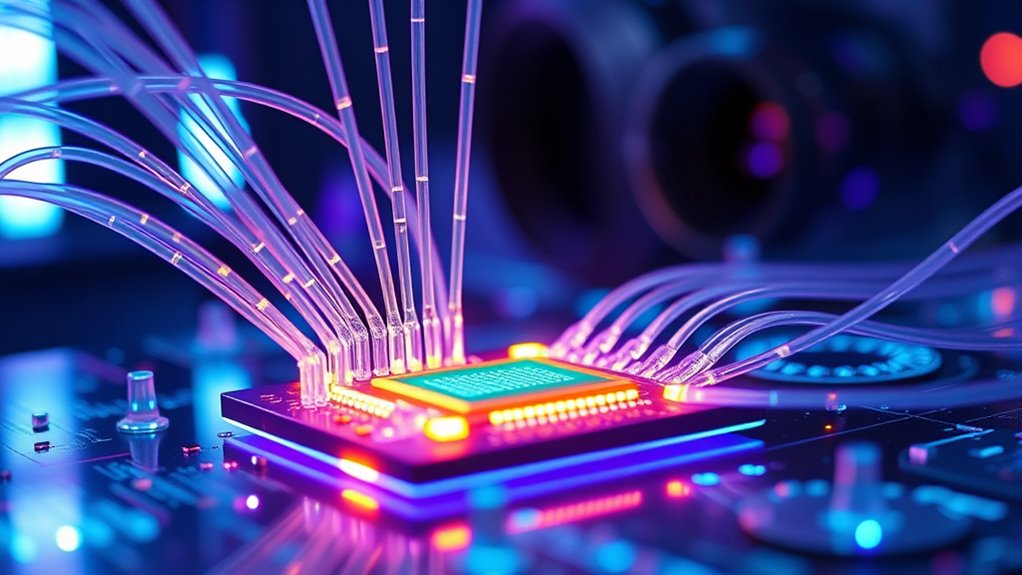AI is revolutionizing photonic computing by enabling it to process data at ultrafast speeds with high energy efficiency. Using AI-driven design, researchers create advanced photonic chips capable of complex neural network tasks, including training nonlinear models with light. This progress allows for massive data handling and real-time computation, making photonics a powerful platform for AI applications. If you keep exploring, you’ll discover how these innovations are shaping the future of light-based computing systems.
Key Takeaways
- AI-driven design optimizes multilayer nanoparticles and photonic structures for tailored light manipulation and improved device performance.
- Deep learning accelerates solving complex photonics problems, enabling rapid inverse design and accurate material property predictions.
- AI algorithms facilitate real-time control and processing in photonic chips, enhancing speed and accuracy of optical neural networks.
- Development of programmable photonic chips with AI integration allows scalable, energy-efficient training of nonlinear neural networks.
- AI supports the integration of photonics and electronics, advancing scalable, high-speed photonic computing architectures.

Have you ever wondered how light can revolutionize AI computing? Today, photonic processors are making that possible by using light instead of electrons to perform complex machine learning tasks. These processors are faster and more energy-efficient than traditional electronic hardware. Recent breakthroughs have led to fully integrated photonic chips capable of executing all essential deep neural network computations optically on-chip. This means you can now achieve ultrafast processing speeds—completing tasks in less than half a nanosecond—with accuracy levels surpassing 92%. By eliminating the need for off-chip electronics in specific neural network calculations, these advancements address previous limitations and bring photonic computing closer to practical, real-world AI applications requiring high speed and low power consumption.
Photonic chips enable ultrafast, energy-efficient AI computations directly on-chip, revolutionizing machine learning with light-based processing.
AI plays an indispensable role in designing and optimizing these photonic systems. Supervised deep learning helps create complex structures like multilayer nanoparticles with tailored light scattering properties. This approach makes solving both direct and inverse photonics problems more efficient than traditional optimization methods. For example, AI can predict 3D surface profiles from laser-machined samples or generate full UV-visible absorption spectra from images. Automating these design processes speeds up development, improves material performance, and supports innovative multifunctional photonic devices that would otherwise rely on trial-and-error methods. Additionally, understanding the signs of spoilage in lemon juice can help improve storage and safety practices for juice products.
Photonics also provides a natural platform for AI computation because of its inherent parallelism. Optical methods excel at parallelized matrix multiplication and image recognition tasks—core functions of AI algorithms. This scalability allows for massive data throughput and notably reduces latency. By integrating optical components directly with AI algorithms, you leverage light’s properties for faster, more efficient processing. This integration enables real-time handling of complex functions, which is crucial for next-generation AI applications. The parallel nature of light allows photonic systems to outperform electronic counterparts, resulting in substantial performance gains across various workloads. Moreover, ongoing research is focused on developing scalable architectures that can support increasingly complex AI models. Advances in photonic integration are essential for realizing fully integrated light-based AI hardware at scale. Furthermore, machine learning algorithms are increasingly being tailored specifically for photonic hardware to optimize their performance and energy efficiency.
A noteworthy milestone is the development of the first programmable photonic chip capable of training nonlinear neural networks using light. Unlike earlier linear-only photonic chips, this innovation enables the computation of nonlinear activation functions—an essential feature for deep learning. By reshaping light behavior to perform these complex operations optically, the chip paves the way for fully light-based AI systems. This breakthrough could dramatically accelerate AI training, reduce energy consumption, and open new horizons for scalable, efficient, light-powered computing architectures. Additionally, advanced fabrication techniques are driving improvements in the precision and reliability of these photonic devices, further supporting their integration into practical AI systems.
Optical neural networks are also exploring new possibilities for tackling complex AI tasks. Their ability to perform high-speed, parallel processing makes them promising candidates for handling increasingly sophisticated AI models, pushing the boundaries of what’s possible with light-driven AI. As the field advances, researchers are exploring the integration of photonics and electronics to combine the strengths of both domains for even more powerful computational platforms. Additionally, innovations in integrated photonic circuits are helping to overcome current scalability challenges, bringing us closer to widespread adoption of light-based AI hardware.
Frequently Asked Questions
How Does AI Improve Photonic Device Fabrication Accuracy?
You can improve photonic device fabrication accuracy by using AI to predict and correct potential issues before manufacturing. AI-driven simulations help you understand how fabrication variations affect performance and allow you to verify manufacturability early on, reducing errors, and optimizes processes like lithography and etching. With AI, you gain precise control over feature sizes, minimize errors, and ensure your devices meet specifications more reliably.
Can AI Predict Future Advancements in Photonic Materials?
Imagine AI as an anticipatory architect, accurately forecasting future photonic materials. You can rely on AI’s advanced algorithms to analyze extensive datasets, identifying promising crystal structures and optical properties before experiments begin. This predictive power propels your projects forward, fast-tracking discoveries and fostering innovation. With AI’s insightful intuition, you gain a clearer glimpse into tomorrow’s materials, transforming theoretical concepts into tangible technologies with unprecedented speed and precision.
What Are Ai’s Limitations in Real-Time Photonic Data Processing?
You face several limitations in real-time photonic data processing. Achieving seamless in-memory computing with non-volatile, multibit storage remains tough. Not all neural network calculations can be done optically, forcing you to rely on slower off-chip electronics. Managing latency, bandwidth, cooling, and power consumption is essential but challenging. Additionally, the lack of a mature ecosystem and scalable materials hampers your ability to develop efficient, integrated systems for real-time AI applications.
How Does AI Facilitate Energy Efficiency in Photonic Systems?
You can see that AI helps make photonic systems more energy-efficient by optimizing how light-based computations are performed. It reduces power consumption through intelligent algorithms that minimize unnecessary processing, while photonic neural networks improve energy use by performing tasks with ten times less energy than electronic systems. This synergy enables faster, low-power data processing, making high-speed applications like healthcare and autonomous vehicles more practical and sustainable.
Are There Ethical Concerns With Ai-Driven Photonic Technology Development?
You should consider that AI-driven photonic technology development raises significant ethical concerns. Privacy risks increase with extensive data collection and potential misuse, making safeguards vital. Military applications could lead to escalation, autonomous weapons, and accountability issues. Society faces job displacement, inequality, and bias risks. Without proper oversight, transparency, and regulations, these technologies might threaten security, privacy, and fairness. Addressing these concerns guarantees responsible innovation that benefits everyone while minimizing harm.
Conclusion
You can see how AI is revolutionizing photonic computing, making it faster and more efficient. Imagine a future where AI-driven photonic chips power ultra-quick data centers, reducing energy use and latency. For example, a tech company might develop AI-optimized photonic processors that handle complex calculations in milliseconds. This synergy promises to open new possibilities in computing, transforming industries and everyday life. Embracing this innovation puts you at the forefront of technological progress.











